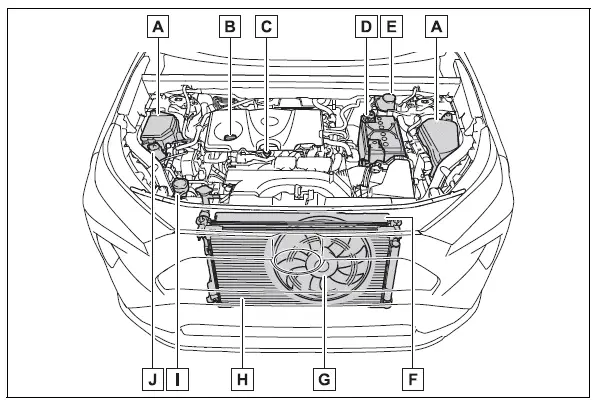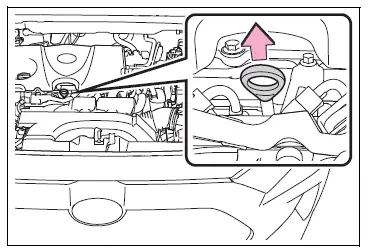Toyota RAV4 (XA50) 2019-2025 Owners Manual: Components

- Fuse boxes
- Engine oil filler cap
- Engine oil level dipstick
- Battery
- Brake fluid reservoir
- Radiator
- Electric cooling fan
- Condenser
- Washer fluid tank
- Engine coolant reservoir
Checking the engine oil
With the engine at operating temperature and turned off, check the oil level on the dipstick.
1. Park the vehicle on level ground. After warming up the engine and turning off the engine, wait about 5 minutes for the oil to drain back into the bottom of the engine.
2. Holding a rag under the end, pull the dipstick out.

3. Wipe the dipstick clean.
4. Reinsert the dipstick fully.
5. Holding a rag under the end, pull the dipstick out and check whether the oil level is above low level mark.

- Low level mark
The shape of the dipstick may differ depending on the type of vehicle or engine.
6. Wipe the dipstick and reinsert it fully.
NOTICE
â– To prevent serious engine damage
Check the oil level on a regular basis.
â– Engine oil consumption
A certain amount of engine oil will be consumed while driving. In the following situations, oil consumption may increase, and engine oil may need to be refilled in between oil maintenance intervals.
- When the engine is new, for example directly after purchasing the vehicle or after replacing the engine
- If low quality oil or oil of an inappropriate viscosity is used
- When driving at high engine speeds or with a heavy load, when towing, or when driving while accelerating or decelerating frequently
- When leaving the engine idling for a long time, or when driving frequently through heavy traffic
â– Engine oil level rise
If the vehicle is repeatedly driven without the engine warmed up, moisture caused by dew condensation inside the engine or fuel which did not burn mixes into the engine oil, resulting in a rise in engine oil level. However, this is not a malfunction.
For example, the engine become difficult to be warmed up in the following situations.
- When driving a short distance
- When driving at a low speed
- When the outside temperature is low
When checking the engine oil, make sure that the engine is warmed up. If the engine oil level exceeds the refill upper limit mark, contact your Toyota dealer.
 Adding engine oil
Adding engine oil
â– Checking the oil type and
preparing the items needed
Make sure to check the oil type
and prepare the items needed
before adding oil.
Engine oil selection
Oil quantity (Low level mark
Refill u ...
Other materials:
The rear cross traffic alert function detection areas
The areas that vehicles can be detected in are outlined below.
To give the driver a more consistent time to react, the buzzer can alert
for faster vehicles from farther away.
Example:
The rear cross traffic alert function is operational when
The bsm main switch is set to on.
The shift ...
Installation (2005/11-2006/01)
Install abs and traction actuator assembly with bracket
Notice:
Do not remove the hole plug before connecting the
brake tube. New actuators are filled with brake fluid.
Install the actuator with bracket with the 3 nuts.
Torque: 19 n*m (194 kgf*cm, 14 ft.*Lbf)
Hint:
The nuts shou ...
Inner rear view mirror
Components
Removal
Remove inner rear view mirror assembly
Disengage the 2 claws and separate the inner rear
view mirror cover as shown in the illustration.
Remove the inner rear view mirror as shown in the
illustration.
Installation
Install inner rear view mir ...

